History of Nagpur Math
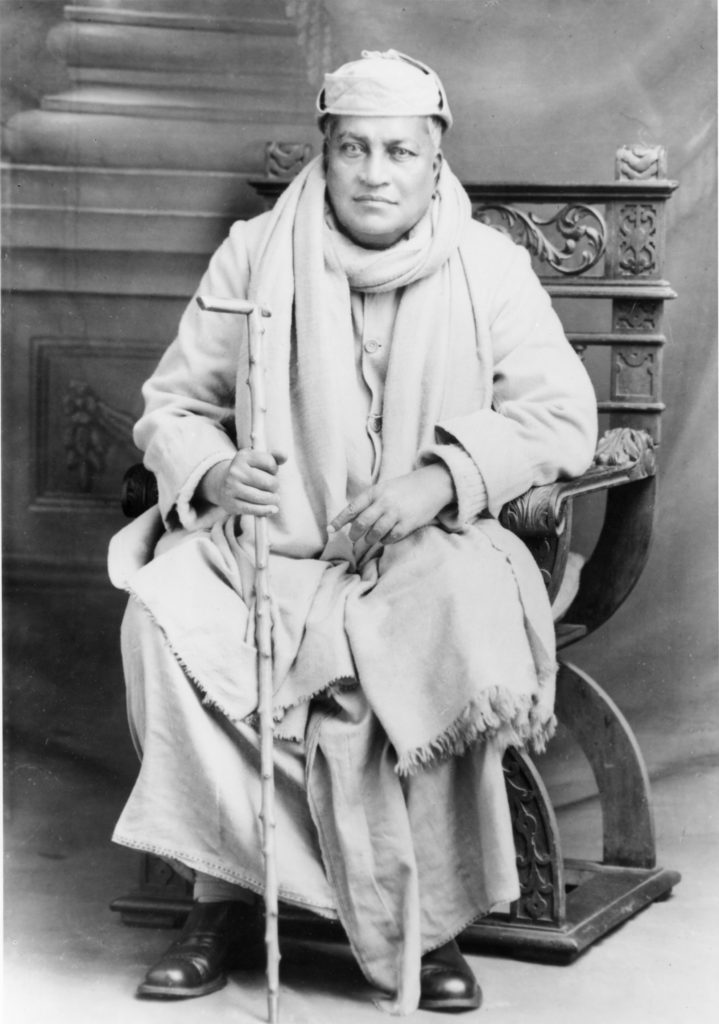
Early 1925:
February 1927
February 1927
Mahapursh Maharaj worships Sri Ramakrishna on Ashrama Land and lays corner stone.
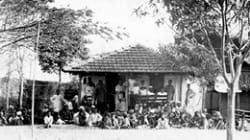
In February 1927, Sri Mahapurushji Maharaj visited Nagpur a second time. This time, he desired to stay on the plot of land meant for the Math. Accordingly, tents were erected for Sri Mahapurushji Maharaj and other disciples. On 16th February 1927 Mahapurush Maharaj worshiped Sri Ramakrishna on the spot where there is now the temple of Sri Ramakrishna, and laid the corner stone of the future Ashrama.
While offering worship, Mahapurushji lost himself in divine consciousness. In that high state of consciousness, looking at the land full of trees and shrubs, he exclaimed – “Jangal me mangal ho jayega”. (‘The forest will become a holy place”).
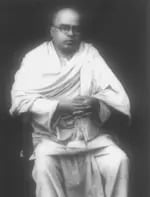
Mid 1927:
Mahapurushji left Nagpur and reached Belur Math on the 22nd February 1927. When the thought of starting an Ashrama at Nagpur for spreading the message of Shri Ramakrishna-Vivekananda arose in his mind he saw before his divine vision a person who would achieve this object – his beloved disciple Swami Bhaskareshwarananda.
After a few days Swami Bhaskareshwarananda, who was then working at Narayanganj in East Bengal (Bengal Desh of today) went to Belur Math on the instructions of the authorities of the Ramakrishna Math and Mission. He was to go to Rajkot. After coming to Belur Math he went to offer Pranams to Shri Mahapurush Maharaj and told him that he was to go to Rajkot. Mahapurush Maharaj said, “Rajkot! But I have already decided to send you to Nagpur. I was waiting for you to tell you so. You will have to go to Nagpur. I have accepted a gift of land there and laid the corner-stone of the temple of Thakur”. According to the wish of Shri Mahapurush Maharaj, Swami Bhaskareshwarananda’s departure to Rajkot was cancelled.
It was not an easy task to start an Ashrama at a distant place like Nagpur. Therefore Swami Bhaskareshwarananda said to Mahapurush Maharaj, “Maharaj, I do not Hindi or Marathi. What can I do at Nagpur? How shall I work there? Who will help me there?” Mahapurush Maharaj replied, “It is the personality that does the work and not the language. You simply go and stay there. You will not have to do anything – You will not do anything ….. Thakur will Himself do everything. The boys who will help you have come upto Wardha ….. So go there and give love to those who will come to you. Tell them about Thakur. Give your life to the people there. Show your life to them. Take the classes of scriptures as long as possible. I vividly see that Thakur’s Ashrama has taken shape at Nagpur.”
Mahapurush Maharaj asked his attendant to give two rupees to Swami Bhaskareshwarananda and said, “Take these two rupees and begin your work.”
September 1928
September 1928
Swami Bhaskareshwarananda begins the Ashram - a shrine, a kitchen, and a Homeopathic Dispensary in that hut.

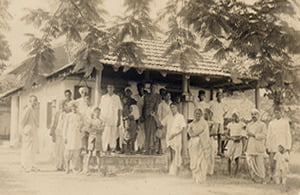
The Homeopathic Dispensary, The work of collecting funds for the construction of the building of the Ashrama was started. Swamiji occasionally wrote articles about Shri Ramakrishna-Vivekananda in the local papers like ‘Hitavada’ and ‘Maharashtra’. He took weekly moral classes in the local Patwardhan High School and Sule High School. Swamiji was occasionally invited to participate in the symposium organised by the Students’ Union of Nagpur University. There was no bus service or rickshaws in Nagpur at that time. Tonga was the only available conveyance. But Swamiji had no money to pay for the fare. So sometimes he used to go on foot to distant areas like Mahal, Itwari, Civil Lines, Sadar etc. Sometimes he even had to personally distribute the handbills of the programmes held in the Ashrama. His noble personality, his love and sympathy for others, his command over English, and his oratory attracted many people to the Ashrama. The young lawyer helping the swami renounced the world at about this time and entered monastic life. Swamiji got great help from him.
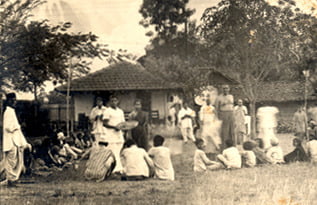
Daridra Narayan Seva in Ashrama Premises
Initially, any great work has to face difficulties and impediments. However, if all actions are performed with the spirit of service to God with full faith in him, all those difficulties and impediments are surmounted by his grace. Here also some persons in society bitterly opposed the work and created various obstructions and problems. On the other hand some people helped the Ashrama a lot. Among them were people of different communities and of different social strata—young and old, men and women, rich and poor, educated and uneducated, Maharashtrians, Hindi speakers, Gujaratis, Panjabis, Bengalis, etc. Sir B.K. Bose, Vice-Chancellor, Nagpur University, Shri P.N. Rudra, Advocate and Shri N.K. Behre, Headmaster, Patwardhan High School, helped the Ashrama in many ways. In the beginning for about six years Shri P.N. Rudra was the Secretary of the Ashrama.
1929-1934 The Ashrama takes shape
- The main building was constructed in 1929-30.
- The library was opened in 1932.
- The temple was constructed in 1933–34.
- Regular worship began in February 1934.
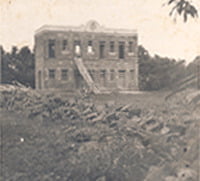
Main Building : Under Construction
Towards the end of 1929, the construction of the main building started and was completed in April 1931. The Library was opened in a small room on the ground floor in 1932. It contained books on religion, culture, philosophy, etc. donated by some generous people. Swamiji now stayed in the shrine room. That year, a hostel of two students was started in the adjacent hall. Later, when the number of students increased, regular religious classes were held for them. The room above the library was now used as the shrine, and the adjacent hall was used as the prayer hall. When Swami Bhaskareshwarananda showed the photograph of the building, under construction to Shri Mahapurush Maharaj, he was extremely pleased and said, “Hindi and Marathi books will be published from this Ashrama.”
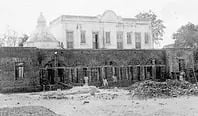
Temple Building : Under Construction
The construction of the temple of Bhagwan Shri Ramakrishna began in 1933 and was completed in May 1934. Shri Ramakrishna had practiced all the main religions of the world. He realized that different religions ultimately lead to the same God who is given different names in different religions. He declared this great truth and thus established harmony among different religions.
To indicate this harmony, symbols of eight chief religions including Hinduism, Buddhism, Zoroastrianism. Islam and Christianity were fixed on the dome of the temple. (This dome was later covered by the roof of tiles due to leakage.) It was the desire of everyone that the installation of the photographs of Bhagawan Shri Ramakrishna, Shri Saradadevi and Swami Vivekananda should be done at the hands of Shri Mahapurush Maharaj. But as Shri Mahapurushji passed away on the 20th February 1934, according to his instructions, Swami Bhaskareshwarananda installed the photographs of Bhagawan Shri Ramakrishna, Shri Saradadevi and Swami Vivekananda on the altar with proper religious rites. Shri Mahapurush Maharaj had told Swami Bhaskareshwarananda – “You install Thakur there.: From that day the regular worship was started in the new temple.
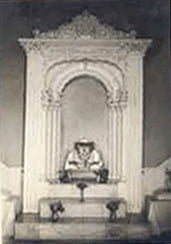
Shrine
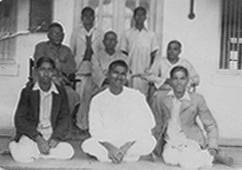
Inmates and Students
November 1934: First initiation by a direct disciples
1936 : Birth Centenary year of Bhagwan Sri Ramakrishana
1936 : Birth Centenary year of Bhagwan Sri Ramakrishana
1936 was the Birth Centenary year of Bhagawan Shri Ramakrishna. This Birth Centenary was celebrated all over the world. The Nagpur Ashrama also celebrated this Centenary. Various programmes like Kirtan, Bhajan and religious discourses were held for about two weeks. The chief attraction of the Centenary Celebrations was the conference of all Religions. The following speakers belonging to various religions were invited from different parts of India.
Prof. G.R. Malkani delivered one more speech on “Relation of Self to Knowledge” (In the light of the philosophy of Shri Shankaracharya). This Conference was held on the 1st, 2nd and 3rd March 1936, and Jagadguru Shri Shankaracharya of Karavir Peeth (Dr. Kurtakkoti, M.A. Ph.D.) presided over the Conference on all those three days.
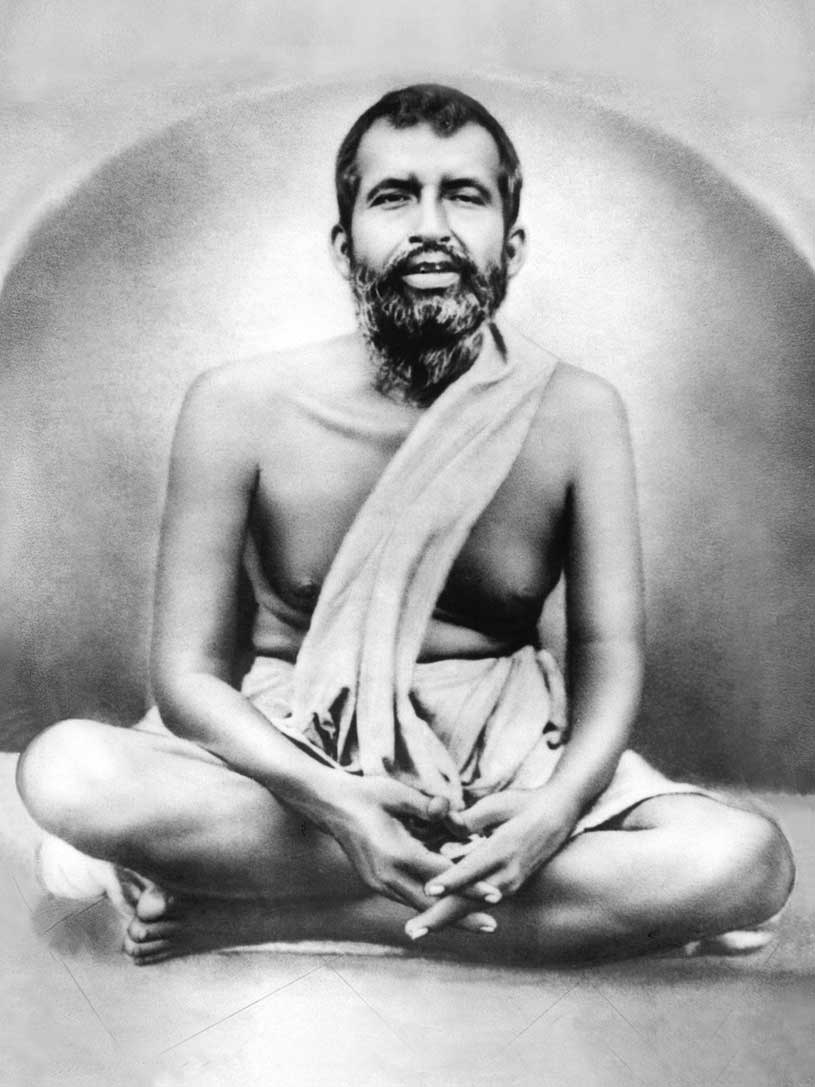
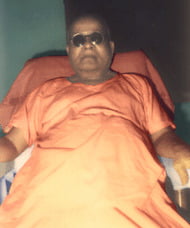
Swami Bhaskareshwarananda
On the last day, Swami Bhaskareshwarananda gave a speech on “Shri Ramakrishna and Universal Religion”. He explained to the audience the significance of the harmony of religions preached by Shri Ramakrishna. His speech was greatly appreciated by the audience. The President of the Conference Jagadguru Shri Shankaracharya also was impressed by this speech. The celebrations were attended by Shri Vinayakbuva Masurkar of Masurashram, Bombay, along with his disciples. He delivered two lectures. There were Bhajans of Shri Tukdoji Maharaj, a renowned saint from Vidarbha, on two days.
A special programme of one day was held for women only. It was presided over by Smt. Parvatibai Patwardhan, wife of Shri Shivajirao Patwardhan of Amaravati.
One more feature of the Centenary Celebrations was the beginning of Publication of books under the title “Shri Ramakrishna – Shivananda – Smriti – Grantha-Mala”, ‘Shri Ramakrishna Vaksudha’ (Marathi) was the first book in this series. Two more books, “Short biography of Shri Ramakrishna Paramahansa Deva’ (Marathi) and ‘Premyoga’ (Hindi), were published in the same year. The Ashrama also got the publication rights and all copies of the Marathi book, ‘Biography of Shri Ramakrishna’ by Late Shri N.R. Paranjape.
1937-1944 New Sadhus joined the Math.
1937-1944 New Sadhus joined the Math.
One student entered monastic life in 1937 after the completion of his education. Between 1937 and 1944, five or six more young men became Sadhus. The activities of the Ashram gradually increased with the help of these Brahmacharis and other intimate devotees.
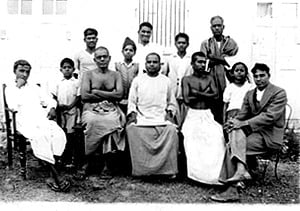
Group Photo
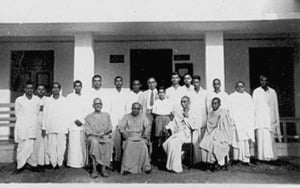
Inmates & Students (1942)
With the help of these Brahmacharis Swami Bhaskareshwarananda began to preach Vedic religion and the teachings of Shri Ramakrishna-Vivekananda through lectures and with the help of magic lantern in adjoining villages like Khamla, Somalvada, Babulkheda, Ajni, Pachpaoli, Indora etc.
Swami Bhaskareshwarananda also used to take these Brahmcharis with him when he went for lectures to various places in Vidarbha like Akola, Amaravati, Akot, Khamgaon, Paratwada, Buldana, Yavatmal, Chimur, etc. and also Betul, Chhinadwada, Mandla, Jabalpur, Durg, Rajnandgaon, Raipur, Bilaspur, etc. in the present Madhya Pradesh. Besides the above places the Sadhus and Brahmacharis from the Ashrama delivered lectures at other places on the occasion of Shri Ramakrishna-Vivekananda Birth Anniversary, Gita Jayanti, Shri Jnaneshwara Anniversary, Dasanavmi, Ganesh Festival, etc.
1945-1965 Consolidation of the Nagpur Ashrama.
1945-1965 Consolidation of the Nagpur Ashrama.
The Ashrama also opened Charitable Dispensaries in the villages of Khamla and Somalwada. Due to some difficulties both these dispensaries had to be closed after a few years. Then Dispensaries were opened in the villages of Ajni and Babulkheda. But these also were closed in 1946 due to some difficulties.
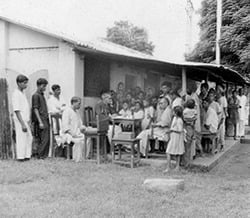
The Dispensary at Indora (1963)
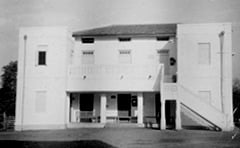
Dispensary Building (1942) in Ashrama Premises
In 1942, a building was constructed for Dispensary, Library and Reading Room, Publication Department and Student’s Hostel. After this construction, the number of students in the hostel was increased.
In 1948, a large building of Vivekananda Vidyarathi Bhavan was constructed in front of the old building, and the accommodation of the hostel was increased to 19 students. Besides this, 6 students stayed in the old building. A spacious lecture hall was constructed on the first floor of Vivekananda Vidyarthi Bhavan and it has been named 'Shivananda Sabha Griha’. The weekly discourses as well as other functions of the Ashrama are held in this hall.
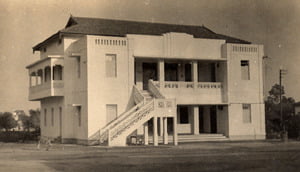
Student’s Home Building (1948)
As the number of the inmates of the Ashrama increased, some more land was obtained and towards the end of 1952, the monastic quarters with 12 rooms were constructed.
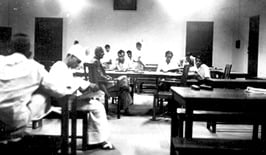
The Reading Room
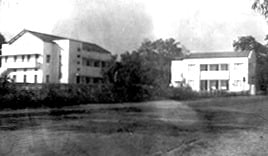
New Library & Publication Building
In 1954, the Ashrama celebrated its Silver Jubilee at the time of the Birth Anniversary of Shri Ramakrishna with a variety of programmes such Kirtan, Bhajan, Lectures and feeding of the poor. On the 5th January 1959, on the auspicious occasion of the Birthday Anniversary of Shri Mahapursh Maharaj, the Library and the Reading Room were shifted to a spacious two storied building constructed on a new plot of land.
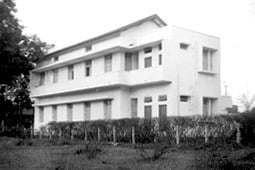
Publication Department & Jivan Vikas Office (1965)
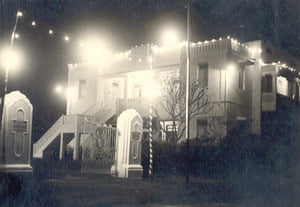
Silver Jubilee 1954
Activities like Shrine Worship and Prayer, Discourses, Library and Reading Room, Homeopathic Dispensary, Publication of books and their sale, coming of a number of devotees, volunteers, and initiated devotees grew significantly to demand bigger and better buildings than the original GIC sheet shade. Hard work by the monks and public support gradually brought about the construction of these buildings by 1954:
(a) Double-story building, including Shrine building (1930–1934)
(b) Double-story building (Present book sale, 1942)
(c) Kitchen and Dining building (1944)
(d) Vidyarthi Bhavan and Sabhagriha (1948)
(e) Monks Quarter (1952).
The land for the library building and some construction in 1955 are the milestones in progress.
A hearty jubilation was thus organized for the Silver Jubilee celebration, which was held for eight days from 19th April 1954 along with the Sri Ramakrishna Anniversary public function. Lectures on Bhagwan Ramakrishna, Vivekananda, Vedanta, Bhagwat Geeta and spiritual themes discussing various religions, Kirten’s Bhajans by eminent personalities were the highlights of the function, along with delightful illumination. Buddha Bhikshu Sheelabhadra of Mahabodhi Society of India Calcutta was the Chief Guest. He spoke about Buddha and Buddhism. Srimad Swami Ojasanandaji, Head, Ramakrishna Ashrama, Ootacamand (Ooty) and the local leaders of the society were among the other illustrious guest speakers.
January 1976: Swami Bhaskareshwaranandaji leaving mortal coils.
January 1976: Swami Bhaskareshwaranandaji leaving mortal coils.
Swami Bhaskareshwarananda worked silently, and he gradually built up the Ashrama and its various activities. He inspired many young men to join the Ramakrishna Order. Through his inspiration, about 25 young men joined the order. He left this world on January 16, 1976, at about 4.30 a.m.

Golden Jubilee 1979
Golden Jubilee 1979
Half a century with Sri Ramakrishna’s blessings on Nagpur and Central India saw the Ashrama well established and well-reputed, having been the training ground of illustriously dynamic and brilliant monks managing not only Nagpur Centre, but many more ashramas run by the devotees in Yavatmal, Amravati etc. acquitting themselves creditably, all respectfully be holden to Swami Bhaskareshwarananda who passed away in January 1976. Activities, material facilities and buildings were properly set up at optimum level. Golden Jubilee function was enthusiastically organized from 18th March to 26th March 1979 under the saintly Presidentship of Srimad Swami Vyomarupananda.
Many a head of other centres, were alumni of Nagpur Ashrama. They reverentially participated as a token of their gratitude. They were Swami Bhashyananda (Chicago), Akamananda (Ranchi), Vyomananda (Rajkot), Atmananda (Raipur), Balaramananda (Mauritius). The then President of the Ramakrishna Sangha Srimad Swami Vireshwaranandaji Maharaj graced the occasion. Rev. Swami Abhayanandaji (Bharat Maharaj) was a guest of honour.
Swami Budhananda (New Delhi), Rev. Swami Ranganathanandaji (Hyderabad) were the important speakers.
Besides these, several monastic brothers attended and witnessed the functions. The entire nine days’ function was a grand divine festival with spiritual feast of learned discourses of Shri Ramakrishna, Holy Mother, Swami Vivekananda, Vedanta, etc. as also melodious Bhajans and Kirtan by eminent experts. The illumination of all the buildings for all nine days added grandeur to the spiritual fair as the discourses inspired inner illumination.
Swami Budhananda (New Delhi), Rev. Swami Ranganathanandaji (Hyderabad) were the important speakers.
Besides these, several monastic brothers attended and witnessed the functions. The entire nine days’ function was a grand divine festival with spiritual feast of learned discourses of Shri Ramakrishna, Holy Mother, Swami Vivekananda, Vedanta, etc. as also melodious Bhajans and Kirtan by eminent experts. The illumination of all the buildings for all nine days added grandeur to the spiritual fair as the discourses inspired inner illumination.
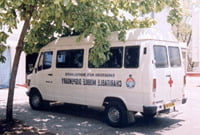
1986 Mobile Dispensary
1986 Mobile Dispensary
1988 Physiotherapy Unit
1988 Physiotherapy Unit
The Math constructed a separate building for charitable Physiotherapy Unit which is equipped with all modern physiotherapy instruments and consists of qualified physiotherapist, assistants and dedicated volunteers. It serves the citizens who suffer from accidents, arthritis, spondylitis, slip disks etc.
The Math constructed a separate building for charitable Physiotherapy Unit which is equipped with all modern physiotherapy instruments and consists of qualified physiotherapist, assistants and dedicated volunteers. It serves the citizens who suffer from accidents, arthritis, spondylitis, slip disks etc.
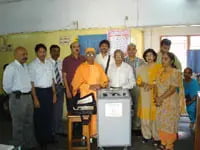
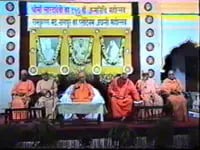
2004 March Platinum Jubilee
2004 March Platinum Jubilee
In March 2004, the Math celebrated its Platinum Jubilee year and the 150th Birth Anniversary of Sri Ma Sarada Devi under the stewardship of Srimat Swami Gahananandaji Maharaj the then Vice President, Ramakrishna Math and Ramakrishna Mission, Belur Math.
Spiritual discourses were delivered by Srimat Swamis Gautamanandaji Maharaj, Satyarupanandaji Maharaj, Nikhilatmanandaji Maharaj and Vishnupadanandaji Maharaj.
2006 Universal Temple
2006 Universal Temple
Newly constructed Universal Temple of Sri Ramakrishna was consecrated on 10th February 2006 by Srimat Swami Gahananandaji Maharaj, the then President Ramakrishna Math and Ramakrishna Mission Belur Math Howrah.
Newly constructed Universal Temple of Sri Ramakrishna was consecrated on 10th February 2006 by Srimat Swami Gahananandaji Maharaj, the then President Ramakrishna Math and Ramakrishna Mission Belur Math Howrah.
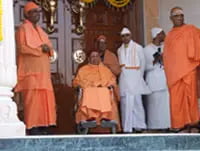
The foundation stone of the new temple was laid by Srimat Swami Atmasthanandaji Maharaj, the then Vice President, Ramakrishna Math and Ramakrishna Mission Belur Math Howrah, on 5th December 2002.
In order to commence the construction of the new Universal Temple, the Old Temple was shifted to the temporary location of the Library Reading Hall by Srimat Swami Gahananandaji Maharaj on 3rd March 2004. Rakshoghna Homa and Vastu Puja was performed on 24th April 2004.
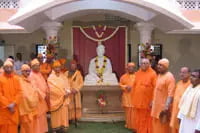
2009 Vivekananda Vidyarthi Bhavan
2009 Vivekananda Vidyarthi Bhavan
The newly constructed Vivekananda Vidyarthi Bhavan was inaugurated on Saturday 3rd January 2009, by Srimat Swami Vagishanandaji Maharaj, a senior trustee of the Ramakrishna Math and Ramakrishna Mission, Belur, Howrah and the President, Ramakrishna Math, Mumbai.
The foundation stone had been laid by Srimat Swami Atmasthanandaji Maharaj, then Vice President of Ramakrishna Order on 22nd January 2007.
The new Vivekananda Vidyarthi Bhavan will house 50 deserving students from rural poor sections. The hostel has an Assembly Hall, Recreation Hall, Kitchen and Dining Hall and a Library (containing books on philosophy, religion, education, culture, literature, sociology, history, arts, science, biography, agriculture etc. and academic course books in various languages such as Sanskrit, Marathi, Hindi, English, and Bengali etc.) and also a C.D. Library to be used by students of the Vidyarthi Bhavan only.
The new Vivekananda Vidyarthi Bhavan will house 50 deserving students from rural poor sections. The hostel has an Assembly Hall, Recreation Hall, Kitchen and Dining Hall and a Library (containing books on philosophy, religion, education, culture, literature, sociology, history, arts, science, biography, agriculture etc. and academic course books in various languages such as Sanskrit, Marathi, Hindi, English, and Bengali etc.) and also a C.D. Library to be used by students of the Vidyarthi Bhavan only.
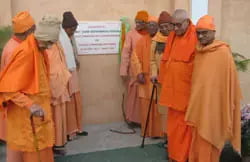
It also has best of the facilities for computer knowledge lab., sports (indoor and outdoor) gymnasium and exhibition hall emphasising the role of spirituality and human values for the all-round personality development of the inmates of the Vivekananda Vidyarthi Bhavan.
